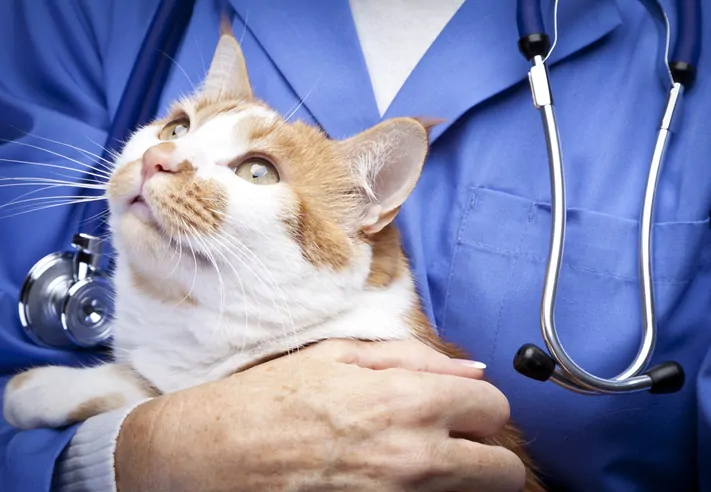If your dog is experiencing allergy issues, you may observe excessive itching and scratching, red and watery eyes, sneezing or runny nose, vomiting or diarrhea, and a variety of other symptoms.
Dogs are allergic to many of the same things that humans are including pollen, mites, fleas, detergents, and some food ingredients.
Allergies in dogs may be diagnosed with food trials, blood tests, and skin tests.
Allergies are managed rather than cured with flea prevention, lifestyle adjustments, symptom management, and weekly allergy shot therapy to build your dog's tolerance to allergens.
If your dog has allergies, they may scratch and lick their skin every hour of the day and even wake you up at night. Perhaps, you've also observed signs of intestinal discomfort or typical allergy symptoms in your dog. While these types of allergy reactions are mild, it's best to determine the source of your dog's allergy issues before itchy spots become open wounds and runny noses become respiratory infections. Here's what you need to know about managing your dog's allergic condition.

Allergies are a result of an overreaction of your dog's immune system to harmless substances in the environment such as dust, pollen, fleas, or certain food ingredients. Your dog's immune system is wired to respond to pathogens like viruses, bacteria, or fungi. When there is an aggressive response to non-pathogenic substances, that reaction is referred to as an allergy.
During an allergic reaction, histamine is released causing inflammation. The most typical allergy signs in dogs are as follows:
The most serious sign of an allergic reaction is anaphylaxis, a life-threatening reaction that manifests as facial swelling, difficulty breathing, sudden diarrhea or vomiting, and collapse. Fortunately, this condition is rare in dogs, but if you notice these signs in your pet, take them to the vet immediately.
Not all allergic dogs experience the same symptoms. Mild to severe symptoms are possible and may impact different parts of the body. Your dog may be hypersensitive to a wide range of allergies. Some dogs may only have one sort of allergy, while others may have several. The most typical dog allergies are:
Most allergies are hereditary or genetic in nature. Bulldogs, Chinese Shar-Peis, Retriever and Terrier Breeds, Shih Tzus, and Lhasa Apsos are a few dog breeds that may be more prone to allergies. However, any breed of dog can be affected. If your dog is predisposed to allergies, they manifest between 6 months and 3 years old. Canine allergies may change with the seasons or if your dog moves to another region.
Testing for allergies takes time. Your veterinarian will start by eliminating any medical or emotional disorders that could result in comparable symptoms. For instance, microscopic skin mites can create sensations on the skin that resemble allergies, yet some allergy therapies can actually make skin mites worse. Additionally, like some people chew their fingernails, an anxious or bored dog could lick or chew their skin.
The following are typical next steps if allergies are suspected:
These tests are frequently tailored to include allergens unique to your dog's region, state, or city.
Keep in mind that treating allergies means managing them, not curing them. You may set reasonable expectations, prevent disappointment, and develop the best long-term management strategy by keeping this objective in mind. Managing your dog's allergies may include actions such as:
Your dog's allergies can be frustrating for both you and your dog. Fortunately, you can make your dog feel better so they are able to enjoy all their favorite activities with you, itch-free, by being patient, vigilant, and following your veterinarian's instructions.
Cat allergies are caused by an over-reactive immune response to typically harmless substances in your cat's environment or food ingredients.
Common, observable signs of an allergic reaction in cats include red, itchy, watery eyes, hives, scratching ears or pawing at the face, itchy rashes, and runny nose or sneezing as well as vomiting and diarrhea.
Veterinarians perform food trials, skin testing, and blood tests to identify the cause of your cat's allergy symptoms.
Treatment for allergies in cats consists of managing your cat's exposure to irritants and supportive care for their symptoms or weekly injections to boost their tolerance to known allergens.
Limiting your cat's exposure to known allergens, keeping a dust-free environment, preventing your cat from going outside, and giving your cat vet-approved supplements are some of the ways you can reduce the frequency of your cat's allergic reactions.
Allergies may cause your cat to scratch and lick, even to the point of getting bald patches or wounds. They may also exhibit intestinal discomfort or symptoms like hay fever. Most allergic reactions in cats may present with mild symptoms but increase in severity over time or come on without a known cause. That's why it is important to consult with your veterinarian to determine the reason for your cat's allergy symptoms and develop an allergy management plan.

When your cat's immune system overreacts to otherwise harmless substances in their environment, it is considered an allergic reaction. For instance, their immune system may respond to items like pollen, dust, or an ingredient in your cat's food as though they were pathogens like viruses or bacteria.
Histamine, which is released as part of the immune system's protective response, can cause inflammation, itching, or difficulty breathing as well as vomiting and diarrhea. This may manifest as conditions of the skin, digestive system, or upper respiratory system. The most common signs of allergies in cats are:
Anaphylactic reactions may cause facial swelling, vomiting or diarrhea, breathing difficulties, collapse, and even death. The good news is that anaphylactic reactions to seasonal, flea, or food allergies are rare. However, you should take your cat to a veterinarian right away if you notice any of these symptoms, particularly after a bee bite, vaccination, or new medicine.
Several allergy signs may be present in your cat at one time, or only one or two may be observable. However, any one of these signs, especially if they manifest, is enough to suspect allergies as the underlying cause. In such cases, it's recommended to visit your veterinarian so they can diagnose and treat your cat.
A range of allergies with mild to severe symptoms may affect many different parts of your cat's body. Some cats are hypersensitive to a wide range of allergens. while others may only experience one specific allergy. The most common types of cat allergies include:
Most allergies are hereditary or genetic in nature. Unfortunately, this makes it challenging to prevent allergies. Any cat can experience allergies, regardless of age, and any cat breed can be susceptible.
Testing for the allergen(s) that trigger your cat's immune response may take time. However, any details you can give your veterinarian about what your cat is exposed to in their environment can help narrow your vet's search area and allow for a faster diagnosis. Your vet will perform diagnostic tests to help identify the cause of your cat's allergy symptoms such as:
It takes a thorough investigation to determine what triggers your cat's allergy symptoms due to the fact that there is a wide range of allergens that can cause similar symptoms.
If your cat's allergy is flea-related, it only takes a few bites from a flea to cause a life-threatening allergic reaction. Year-round flea prevention is the best way to protect your pet from allergic reactions to flea saliva. Fleas have the ability to survive in even the coldest weather. Your veterinarian can recommend the best flea preventative for your cat.
If food allergies are the source of your cat's allergy symptoms, they must adhere to a strict diet consisting of foods that are unlikely to trigger allergy symptoms. Your veterinarian can assist you in locating substitute medications and hypoallergenic food that your cat is able to tolerate.
Environmental allergies and seasonal allergies are tricky since you can't regulate the pollen count, and environmental allergens are more difficult to manage. Depending on the severity of your cat's symptoms, seasonal allergies may require long-term therapies and drugs that are given either at regular intervals or only when an attack occurs.
Desensitization therapy is another option to explore if your cat has environmental allergies. This entails once-a-week injections personalized for your pet based on their allergy test. Minuscule amounts of your pet's allergens are present in the injections, which allows your cat to develop a tolerance. While it can take months for the injections to start working and not all cats will see a noticeable difference, it may still be worth the effort for cats with severe allergy symptoms.
Other interventions you might try to limit allergic reactions in your cat include:
Allergies are frustrating for both you and your cat. If you have the right allergy management plan, you can help your cat feel better. This plan can allow you and your cat to enjoy all their favorite activities without uncomfortable symptoms such as itchiness.
The Thanksgiving holiday is a time for family, friends… and food. Lots and lots of food. For many pet owners, this can be a stressful time, as they worry about their furry friends getting into the holiday feast. However, with a little planning and preparation, you can keep your pet safe and enjoy the holiday season stress-free. By following our simple tips, you can help to ensure that your pet has a safe and happy Thanksgiving.

Pets beg because they know it works. But resist the temptation to give in and feed them table scraps. Fatty foods can cause pancreatitis, an inflammation of the pancreas that can be life-threatening. Turkey skin is also a hazard because it can get stuck in your pet's throat or cause an intestinal blockage. And chocolate is poisonous to dogs and cats, so keep those dessert plates out of reach!
Here are some unsafe foods that pets can NOT consume:
• Turkey bones, turkey skin, and turkey gravy
• Ham
• Yeast dough/raw dough
• Grapes
• Onions
• Garlic
• Stuffing
• Casseroles
Here are some safe foods that pets CAN consume:
• Turkey meat
• Cranberries
• Pumpkin
• Apples
• Carrots
• Green beans
• Sweet potatoes
If you notice that your dog has eaten something from the unsafe foods list, it is important to seek veterinary care immediately. If he/she reacts badly after consuming a food item marked as "safe" then there might be an allergy or other issue with this particular meal, and they should see their vet right away!
With all the hustle and bustle of Thanksgiving, it's easy to forget about your furry friends. But leaving them alone for too long can be stressful and dangerous. If possible, have someone check on them every few hours to make sure they have food, water, and a clean litter box or yard. And never leave them unsupervised around candles, fireplaces, or space heaters.
With all the coming and going on Thanksgiving Day, it's important to keep your pets away from the door to prevent them from slipping out unnoticed. Put up a baby gate or keep them in a quiet room where they can't get underfoot or escape.
Thanksgiving is a great time to spend with family, friends and loved ones. However, it’s also important to remember that your pets are an important part of the family as well. That’s why we want to remind our readers to keep their pets safe this holiday season. Be sure to keep them away from any food or drinks that may be harmful and always have plenty of fresh water available. If you need help keeping your pet healthy and safe during the holidays, don’t hesitate to call us. We would be more than happy to offer advice or book an appointment for your furry friend. We believe by following these simple tips, you can help ensure that your pets have a happy and safe holiday season!
As the leaves start to change color and the temperature begins to drop, we know that fall is officially here. For many of us, that means pumpkin spice lattes, cozy fires, and watching our favorite football team on Sundays. But for our furry friends, Fall can pose some hazards that pet parents need to be aware of. Here are a few tips on how to keep your pet safe this season.

Pets and Halloween candy are a dangerous combination. According to the ASPCA Animal Poison Control Center, chocolate is the number one toxin pet parents need to be aware of during Halloween. Dogs especially are attracted to the smell and taste of chocolate, but it can be very harmful—even fatal—if ingested in large quantities. So be sure to keep your Halloween candy out of reach of your furry friends!
The Holidays can be full of tempting treats for your pet, but many common holiday foods are actually poisonous for animals. Don't let your pet eat any candy, chocolate, raisins, grapes, or nuts, and be careful with foods that contain onions or garlic. Turkey skin can also be problematic for pets, as it can cause pancreatitis. Keep all food out of reach of your animal companions, and make sure they have plenty of toys and attention, so they don't feel left out while you're busy cooking.
Another hazard to pets during the fall season is cold weather. While we can bundle up in a warm coat when the temperature starts to dip, our pets can't do the same. If you live in an area with cold winters, make sure your pet has a warm place to sleep inside your home. You may also want to invest in a doggie sweater or coat for extra protection when they go outside. Just like us, cats and dogs can get colds when they're exposed to chilly temperatures, so if you notice your pet sneezing or coughing more than usual, it's time for a trip to the vet.
Finally, autumn is peak season for ticks and fleas. These pesky critters love nothing more than to hitch a ride on our four-legged friends and make themselves at home. Not only are they annoying, but they can also transmit diseases like Lyme disease and Rocky Mountain spotted fever. Be sure to keep up with your pet's flea and tick prevention during the fall months (and year-round!) and check them for any unwanted visitors after they've been outside playing.
Need your preventatives this Holiday season? Bring your pet into My Pets Wellness for their wellness exam so we can make sure your pet is happy & healthy this holiday season. By following these simple tips, you can help ensure that your furry friend has a safe and happy fall season!
Urinary tract infections, or UTIs, in cats can be excruciating and, if left untreated, can lead to severe complications. Therefore, it's important to keep an eye out for the symptoms of urinary tract infections in cats. Common signs and symptoms you may notice in your cat include:
Urinary tract symptoms are common in cats, especially if they are 10 years or older. Though, we see cases anywhere from 2 years old and on. The urine in your cat's bladder should be sterile, but if bacteria get into the bladder, they can multiply and spread throughout the urinary tract, causing infection, however, such cases are rare.
Endocrine disease contributes to the majority of urinary tract infections in cats and is characterized by the overproduction or underproduction of hormones by the endocrine glands. A disordered adrenal gland, thyroid gland, or pancreas can cause your cat to have excessive thirst, frequent urination, and dehydration.
Low-level, chronic dehydration increases the chance of your cat developing a urinary tract infection because a dehydrated urinary tract allows bacteria to develop and reproduce more efficiently. Kidney failure later in your cat's life may be connected to persistent or untreated urinary tract infections.

Feline lower urinary tract disease, or FLUTD, is a general term that covers a wide range of urinary tract symptoms, which are very common. With FLUTD, crystals, stones, or debris can slowly accumulate in your cat's bladder or urethra, resulting in an obstruction that can impede bladder emptying. If neglected, these illnesses can become serious or even fatal.
For cats with FLUTD, urinating might be difficult, uncomfortable, or even impossible. Additionally, they can urinate more frequently or improperly outside of their litter box (occasionally on surfaces that are cool to the touch such as a tile floor or bathtub).
Although cats of any age can get feline lower urinary tract disease, it's most common in cats that are overweight and middle-aged who have limited to no access to the outdoors, eat a dry food diet, or do not get enough physical activity. Because their narrower urethras are more likely to become obstructed, male cats are more vulnerable than female cats to developing a urinary disease.
Whether your cat has a UTI or FLUTD, both conditions require veterinary care. Contact your veterinarian or the closest emergency vet right away if your cat is struggling to urinate or howling in agony as your cat may be having a medical emergency.
Your veterinarian will conduct a thorough physical examination to help determine how your cat is feeling and will conduct a variety of tests to learn what is causing your cat's urinary tract symptoms, such as:
Some tests may take longer to perform than others so your veterinarian may prescribe a broad-spectrum antibiotic to start your cat on until the results come in. Once all the test results are completed, your vet will provide you with a more targeted treatment plan for your cat.
Once your vet has identified the exact cause of your cat's urinary symptoms and prescribed a treatment plan, it's important to follow their instructions precisely and give all prescription medications as directed and on time. Making sure your cat has plenty of water close by during recovery and making vet-recommended changes to their diet may also speed the recovery process.
Yes. Heartworm can be found in all 50 US states. It is more prevalent in the south and in areas with larger populations of mosquitos.
Heartworm is spread by mosquitos. It is not spread directly between mammals. For example, a human cannot get heartworm from a dog.
Dogs and ferrets are the most at risk; however, cats can become infected as well. Especially in the case of ferrets, prevention is very important as it can be hard to treat once infected.
Yes! Heartworm is a serious illness that can kill your pet. Proper preventative measures are essential to keeping your animal safe.

Heartworm disease in pets is a severe and sometimes fatal condition in the United States and many other countries around the world. Dogs, ferrets, and to a lesser degree, cats are susceptible to heartworm disease, which is caused by foot-long worms that reside in the lungs, heart, and arteries. These worms also find hosts in wolves, foxes, coyotes, sea lions, and in a few instances, humans. Heartworms can cause heart failure, severe lung disease, and other species-specific health consequences:
Canines serve as natural hosts for heartworms, fostering the worm's maturation into an adult worm. After that, the parasite will reproduce and produce offspring. There have been reports of dogs harboring hundreds of worms, and if left untreated, this number can increase exponentially. Heartworm disease causes irreversible damage to a dog's heart, lungs, and arteries, impacting its health and quality of life even after the parasites have been eliminated. This makes heartworm prevention very important for dogs. If your pet becomes ill, treatment is required, and it should start as soon as possible as the worms can multiply exponentially.
While cats can become infected, it is less common. Cats infected with heartworms usually have no more than one to three adult worms in their bodies and sometimes have no adult worms at all. Heartworm sickness in cats is frequently misdiagnosed, but it's important to know that even juvenile worms can harm cats. The juvenile worm causing heartworm linked respiratory disease (HARD). Cats can only be protected from the effects of heartworm disease through prevention because the medication used to treat heartworm infections in dogs is not safe for cats.
Ferrets are susceptible to heartworm, but treatment options are less available. Like cats, ferrets' smaller heart size makes them susceptible to fatal damage from even a tiny number of worms, perhaps as few as one. Heartworm disease in ferrets is difficult to diagnose, and there is no reliable cure. For ferrets prevention using a heartworm prophylactic medicine is highly recommended.
While there may not be any symptoms in the early stages of infection, symptoms of disease will start to show as the worms mature and multiply, intensifying the severity of symptoms as they spread. Here are the four classes of heartworm infection:
Only mosquitoes can spread heartworms from one animal to another. Microfilariae, which are immature heartworms, enter the mosquito's system when it bites an infected animal. Within two weeks, the microfilariae inside the mosquito transform into infectious larvae, which transfer to other mammals as the mosquito feeds on them. Contrary to dogs, infected cats do not frequently have microfilariae circulating in their blood, and so are less likely to spread the heartworm infection to another mosquito.
Within six months, the infectious larvae develop into adult heartworms. The larvae travel through the animal's body during the first three months before arriving at the lungs' blood arteries. The young worms spend the last three months maturing with females reaching lengths of up to 14 inches. Severe lung and heart illness are caused by the damage adult worms cause to the blood arteries and to the heart's capacity to pump blood. By the time the animal starts to exhibit the signs of adult heartworm infection, it already has heartworm disease.
When both sexes of adult worms are present, they will procreate new microfilariae within five to seven months after infection. The immune system of the animal may mount a response to the microfilariae that may harm other organs in the process. When a mosquito attacks an infected animal and picks up the microfilariae, the life cycle is recommenced. Infectious heartworm larvae can infect other mammals 10 to 2 weeks after developing from microfilariae to infective larvae inside the mosquito. In dogs, adult heartworms can live for five to seven years, while in cats, they can live for months or even years.
According to a Stanford University study, the first case of canine heartworms in the United States was found in the Southeast in 1856. The American Heartworm Society warns that heartworms are spreading across the nation and around the world, despite it earlier being more prevalent in the Atlantic and Gulf coast states. While the Southern U.S. has historically been linked to heartworm disease, pets in all regions of the country are at risk for heartworm disease at any time of year. All fifty states have reported cases of the sickness, according to the U.S. Food & Drug Administration.
Even dogs who spend most of their time inside are not completely protected from mosquito bites in areas with high numbers of stray or wild animals. Moving pets from one state to another may bring heartworms into areas where it has not previously been an issue. This is particularly evident with dogs from heartworm-endemic areas that are brought into shelters outside their home region during disaster relief operations. For instance, during Hurricane Katrina in 2005, over a quarter of a million animals were relocated from the New Orleans region to new residences across the nation. Some of these canines brought heartworms with them. According to AHS, there are more than a million heartworm-afflicted pets in the United States.
Ticks spread a host of serious, incurable diseases to cats, dogs, and people. Therefore, tick control and prevention are as important to your family's health as it is to your pet's. Here we will look at why tick control is important for your cat, your dog, and your family as well as some ways you can prevent these pests from causing you and your pet serious, irreparable harm.
Ticks are a parasitic form of arachnid, like spiders, scorpions, and mites, that feed on both human and animal blood. They rely on their hosts to bring them onto your land or around your house because they can't fly or jump to go around. Ticks are frequently carried by wild animals when they occur in your area. Deer, horses, rats, and other types of wild animals can all serve as tick hosts. Cats and dogs typically act as carrier hosts for parasites once they are on your property, which allows the parasites to enter your home.

Ticks exist in a variety of temperature zones and are found all across the country. However, they seem to prefer the damp, shady woodlands of the Northeastern US the most. A US News report found that Pennslyvania had the highest incidence of tick-borne illness in the United States, followed by many of its east coast neighbors. Minnesota and Wisconsin in the northern Midwest also made the list.
Ticks transfer disease-causing viruses, bacteria, and microscopic parasites to pets and humans through their saliva which enters their host's bloodstream when the tick bites. The most common diseases spread by ticks include:
Many tick-borne diseases have common symptoms that can include body aches, joint pain, headache, fever, rash, fatigue, stiff neck, swollen lymph nodes, and facial paralysis.
Ticks are relatively easy to locate once they've settled in for a bite because, if unbothered, they will feed in the same spot for anywhere from 3 to 10 days. Ticks typically seek out the warm, moist cracks or crevices of their host for comfort and less chance of detection. So if you're checking your dog or cat for ticks make sure to look deep within your pet's coat, inside and around their ears, around their neck, and between their legs and toes.
To get rid of ticks on your pet and prevent them from getting new ones, most pet owners one or more of the following:
If you think your pet has been bitten by a tick, we advise running a blood test that we send to the lab 4 weeks after the attachment of the tick. It takes a month for the antibodies to circle in the blood stream to detect if a tick-borne disease has occurred.
Some medications used to treat ticks in dogs are harmful to cats so make sure you purchase tick treatments that are formulated specifically for your pet. Tick control medications are often found in combination with flea control and prevention medications so be sure to check the label to see if the product you choose protects your pet from more than one kind of pest. To identify the best tick prevention for your cat or dog, consult your veterinarian.
Vomiting occurs in dogs as a response to digestive indiscretions, food sensitivities or allergies, infections, digestive tract blockage, and other underlying conditions.
Vomiting is the ejection of the contents of the stomach and upper intestines, while regurgitation is the expulsion of food and other contents from the esophagus.
Vomiting frequently occurs in conjunction with diarrhea, gas, and bloating in dogs and can lead to dehydration, electrolyte imbalances, and occasionally death.
Vomiting in dogs may be treated with short fasts, bland diets, fluid therapy, prescription medications, and in serious cases, surgical intervention.

Vomiting is a messy symptom of gastrointestinal distress in dogs that many dog guardians face and that may cause serious complications for your pup. That's why it's important to seek veterinary attention for your furry family member as quickly as possible when you are unsure why your dog is throwing up.
Some illnesses that resemble vomiting could be caused by a different condition. Active retching or heaving along with throwing up food or bile are indicators that vomiting is your dog's issue. Liquids, mucus, or white or yellow foam may also be visible.
On the other hand, regurgitation is more likely if your dog is bringing up food they've recently eaten, particularly if it's undigested food and there isn't any heaving, retching, or gagging involved, instead the food seems to pop out unexpectedly.
Regurgitation is the expulsion of the contents of the esophagus, whereas vomiting is the ejection of the contents of the stomach and upper intestine. A violent cough can also resemble vomiting in both appearance and sound; some canine coughs even produce foam.
Vomiting, regurgitation, and coughing all have unique causes and hence require unique treatments, though the distinctions can be slight. Any observations you make will therefore aid your veterinarian in making an accurate diagnosis.
There are multitudes of diverse reasons why your dog may be vomiting. Some of the most common causes of vomiting in dogs include:
Fortunately, most occurrences of vomiting in healthy dogs may be quickly and effectively treated. Sometimes, however, your dog's vomiting may be a symptom of a dangerous or even fatal underlying condition. If your pet develops any of these signs, you should take them to the vet right away:
Check your dog for dehydration by looking for dry or pale gums and "tenting" on the skin. You can check for tenting by pulling up on the skin between your dog's shoulder blades and observing how it settles back down. Your pup is likely dehydrated if it continues to stand up like a tent.
The underlying cause of vomiting in your dog will determine the course of treatment. To rule out a foreign body, an underlying ailment, or other problem, your veterinarian may want laboratory tests or X-rays in addition to a physical examination. Possible ultrasound may also be needed.
These diagnostics assist your vet in identifying the source problem more, avoiding harmful complications, and providing more effective, and often, less expensive treatment.
Here are a few typical treatments for the majority of conditions that cause vomiting in dogs:
Do not administer any human drugs or over-the-counter medications to dogs without first seeing your veterinarian.
You can reduce your dog's risk of developing conditions that cause vomiting by:
These suggestions may be helpful in preventing other health issues as well. If your pet vomits three or more times in an eight-hour period or has other concerning symptoms, don't hesitate to get vet help right away, as some conditions which cause vomiting in dogs can be life-threatening and time-sensitive.
If you're a pet owner, it's important that you know about pancreatitis in cats. This potentially life-threatening condition can cause a lot of pain and discomfort for your furry friend, so it's crucial to be able to recognize the signs and get them the help they need. In this blog post, we'll discuss what pancreatitis is, the symptoms to look out for, and how you can help your cat recover. Thanks for reading!

Pancreatitis occurs when the pancreatic enzymes are activated prematurely and begin digesting the pancreas itself. This can lead to inflammation, pain, and potentially serious complications. Pancreatitis can be acute or chronic and can occur in any age or breed of dog or cat. However, certain risk factors such as obesity, diabetes, and certain medications may make your pet more likely to develop pancreatitis. If you suspect that your pet may have pancreatitis, it is important to contact your veterinarian immediately. Pancreatitis can be a serious condition, but with prompt treatment, most pets make a full recovery.
Bloodwork and an FPLI test for Feline Pancreatic Enzyme Abnormalities
Radiographs and ultrasound to look for enlargement of the pancreas or masses
No specific treatments exist for pancreatitis, and therapy involves primarily supportive care such as:
Intravenous fluids are used to maintain hydration, PREVENT DEHYDRATION and correct electrolyte Imbalances.
Medication(s) may be required during nauseating episodes like vomiting and diarrhea that often come alongside the disease process itself.
Pain medications are also administered; these can include anti-inflammatory drugs or even opioids are commonly used for cats with pain such as buprenorphine.
Nutritional Therapy can be used to make sure your cat starts to eat again is important to avoid complications from prolonged anorexia, such as hepatic lipidosis. Esophageal or nasogastric tubes may be inserted as needed. Cats tolerate dietary fat better than dogs with pancreatitis, so feeding a low-fat diet is unnecessary. A highly digestible food is preferred to high-fiber diets.
The most common complications associated with pancreatitis include:
Monitoring requirements vary depending on the severity of pancreatitis. Ideally, hospitalization may be required to repeat vitals, assess hydration, pain, and weight gain. Repeating bloodwork, blood pressure and FPLIs to assess the pancreatic inflammation is subsiding is also important. If we are doing well, we can treat on an outpatient basis if monitored clinical signs have improved.
The prognosis for cats with acute pancreatitis is guarded and very serious, but with prompt diagnosis and treatment, most cats make a full recovery. If your cat is showing any symptoms of pancreatitis, please book an appointment with your veterinarian as soon as possible. Early diagnosis and treatment are key to a successful outcome for your kitty.
If you're a pet owner, you've probably heard of kennel cough. It's a contagious respiratory infection that often affects dogs who stay in boarding facilities, go in for grooming appointments, or even casual interactions outside at the dog parks can lead to exposure and infection!
But what should you do if your pet contracts kennel cough? Is there anything you can do to help them recover? In this blog post, we'll discuss the symptoms and treatment options for kennel cough in pets. We'll also provide some tips on how to prevent your pet from getting sick in the first place. So, if you have a furry friend at home, read on to learn all about kennel cough!

The airborne viruses and bacteria that are released when infected dogs cough are the principal carriers of kennel cough. It might unintentionally go onto someone's hands, shoes, or inanimate items. The canine parainfluenza virus, canine adenovirus, and Bordetella bronchiectasis are the three pathogens that are most frequently linked to cases of kennel cough. Kennels, animal shelters, grooming salons, and dog exhibitions are examples of settings where many dogs are kept in close quarters and where the kennel cough is easily disseminated.
Not all dogs who are exposed to the bacteria that cause kennel cough will become ill. Stress, general health, and respiratory irritants like smoke or dust all contribute.
Most dogs who have kennel cough only have minor symptoms. A dry, hacking cough is the predominant symptom, and appetite loss is also occasionally present. The cough may be loud and high-pitched. The cough is generally productive- meaning you may witness your pet hack foam or fluid out in small volumes. Bronchopneumonia can develop in some patients and may be secondary due to the presence of associated bacteria.
The majority of dogs recover in 1-2 weeks and are typically self-limiting. However, young, unvaccinated, or immune-comprised dogs are more likely to become clinical for the disease and can be more susceptible to developing bronchopneumonia.
Symptoms include:
A physical examination and medical history are used to make the diagnosis. When the trachea is touched, dogs with this condition typically cough. Because the veterinarian needs to confirm that Canine Distemper is not the cause of coughing, accurate information about immunization history is important.
Even while dogs with minor illnesses might not need medication, cough suppressants and anti-inflammatories can make them feel better. Antibiotics and bronchodilators are used to treat infections that are more severe.
Vaccination is available for Bordetella bronchiectasis, canine adenovirus type 2, canine parainfluenza virus, canine distemper, and canine influenza. Infections with other members of the kennel cough complex cannot be prevented. Vaccine against adenovirus type 2, parainfluenza and canine distemper is generally included in the basic puppy series and subsequent boosters (the DHPP or distemper-parvo shot). For Bordetella bronchiseptica, vaccination can either be given as a separate injection at 4 months of age with a booster or as a nasal immunization and as early as 3 weeks of age. Kennel Cough can still occur occasionally in vaccinated dogs, but it is less severe and decreases the chance of potentially getting secondary pneumonia.
With My Pets Wellness, you can count on us for all your pet's urgent care needs. We will do whatever it takes to get them taken care of right away and make sure they're happy & healthy.
Phone: (855) 461-8259
Email: [email protected]